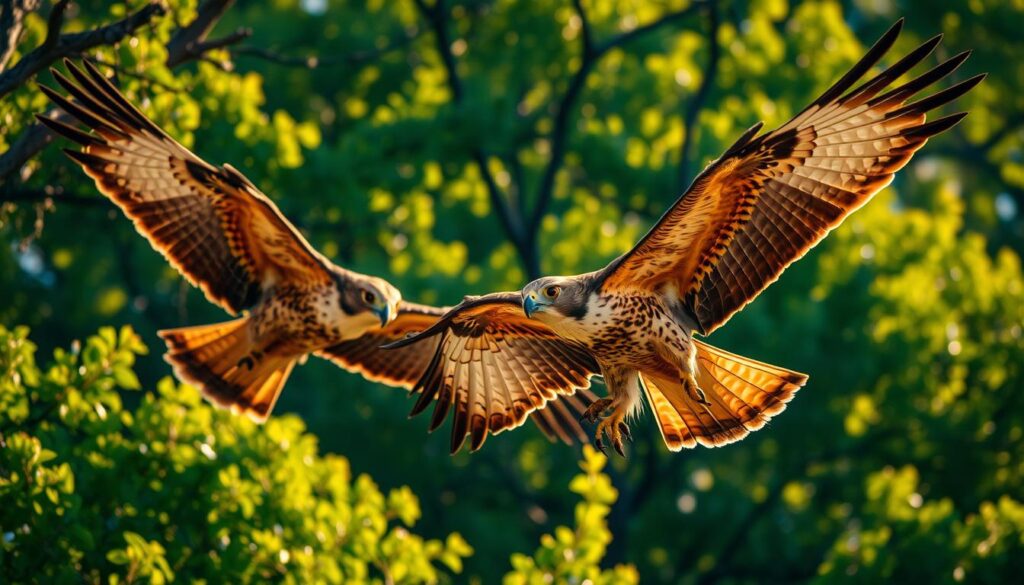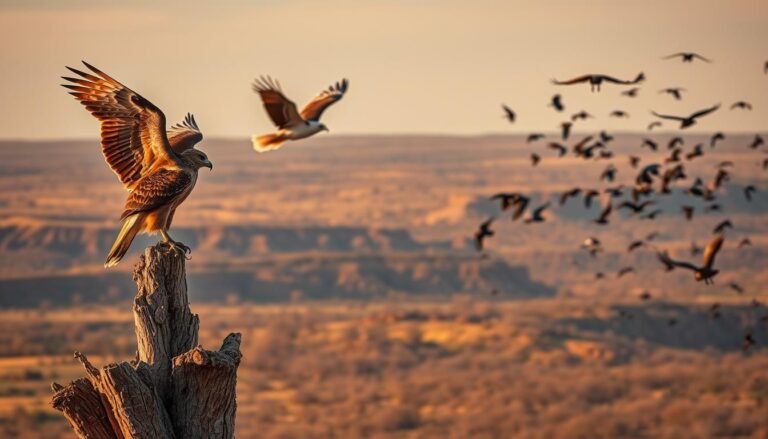Birds of Prey Arkansas: As I journey through Arkansas’s stunning scenery, I’m always amazed by the soaring birds of prey. This state is a habitat for many raptors, crucial to its ecosystems. Species like the grand Red-tailed Hawks and mysterious Barred Owls make Arkansas a prime spot for birdwatchers.
This piece will dive into the lives of these fascinating birds of prey. We’ll look at their beauty and the vital conservation work that protects them. Join us as we explore birdwatching in Arkansas, full of nature’s thrilling moments.
Birds of Prey in Arkansas Key Takeaways
- Arkansas hosts a diverse range of birds of prey, vital to local ecosystems.
- Birdwatching opportunities abound in various regions of the state.
- Conservation efforts are crucial for maintaining the habitats of these raptors.
- Understanding bird behavior enhances the birdwatching experience.
- Many birds of prey have unique hunting techniques that adapt to their environment.
Overview of Arkansas’s Unique Birdwatching Opportunities
Bird watching in Arkansas is a wonderful experience. It draws both passionate enthusiasts and those who just love to observe. The state is home to over 400 bird species, with about 350 seen regularly. This makes it one of the best places for spotting birds. Its varied landscapes, like the Ozark Mountains and large wetlands, offer great chances to see birds.
Key Regions for Birdwatching
Arkansas has some areas that are especially good for birdwatching:
- Bald Knob National Wildlife Refuge: Famous for a variety of shorebirds and waterfowl, particularly during migration seasons.
- Holla Bend National Wildlife Refuge: A hotspot for Bald Eagles and other diverse species during winter.
- Magness Lake: Recognized as an Important Bird Area (IBA), attracting Trumpeter Swans in winter.
- Fort Chaffee Wildlife Management Area: Offers habitats frequented by migratory birds.
Best Seasons for Birdwatching
The best time to bird watch in Arkansas is during spring and fall. These seasons are great for seeing migrating birds. In fall, you might see Northern Harriers and Short-eared Owls. Spring welcomes many birds back for nesting. Areas like the Mississippi Flyway become busy, as lots of birds pass through.
Importance of Habitat Preservation
Keeping the right habitats is key for the birds of Arkansas, including predators. Over time, losing habitats has put many species at risk. The greater prairie-chicken was lost in the 1930s. Now, there are efforts to fix wetlands and forests. This helps birds and improves bird watching. Protected areas keep local and migratory birds safe for future watchers.
Common Birds of Prey Found in Arkansas
Arkansas has many unique birds of prey. These raptors are fascinating to watch and study. Let’s look at three popular species and their special traits.
Red-tailed Hawk
The Red-tailed Hawk is well-known in Arkansas. It has a red tail and wide wings. You can find it in fields, forests, and cities. Its loud call is easy to recognize. They hunt small animals and are skilled flyers.
Cooper’s Hawk
The Cooper’s Hawk is fast and agile. It lives well in suburbs, flying through trees. With its blue back and orange chest, it’s easy to spot. These hawks catch birds by surprising them. They help control bird numbers in cities.
Barred Owl
The Barred Owl loves forests. Its call sounds like “who cooks for you.” This owl has brown and white feathers. Barred Owls hunt at night, eating small animals and birds. They adapt well to different places, helping Arkansas’s nature thrive.
The Role of Birds of Prey in Ecosystems
Birds of prey are vital as top predators in ecosystems. They keep small animal populations in check, helping the environment stay balanced. By understanding their role, we learn about nature’s interconnections. Raptors in Arkansas show the importance of bird conservation.
Top Preditors and Their Impact
The Red-tailed Hawk in Arkansas can have a wingspan of nearly five feet. Such size lets them control rodent populations. This protects crops and keeps farms healthy. Birds like the Peregrine Falcon dive at speeds over 200 mph, showing how predators affect other animals.
Food Chain Dynamics
In Arkansas, different species show the complexity of food chains. The Sharp-shinned Hawk, smaller than the Cooper’s Hawk, weaves through trees to catch prey. At night, Great Horned Owls and Barred Owls hunt rodents, playing their ecosystem role.
Raptor species indicate a healthy ecosystem and habitat. Keeping their numbers stable manages pests and reduces diseases by controlling small animal populations. Bird conservation in Arkansas is crucial. Habitat loss, pollution, and human interference threaten raptors. Protecting these birds boosts ecological strength and biodiversity.
Hunting Techniques of Arkansas Birds of Prey
In Arkansas, birds of prey have cool ways to hunt that show how amazing they are. They use different methods to catch their food. They mainly fly in two ways: soaring high and gliding, or flying quietly.
Soaring and Gliding
The Red-tailed Hawk is a famous bird of prey in Arkansas. It’s good at soaring and gliding. These hawks go over large areas looking down for food. They have big wings, from 3’6″ to 4’4″, helping them glide smoothly. In some seasons, they fly up to 24% of the day.
- Migration Timing: Red-tailed Hawks migrate from August to early January. The best time to see them is from late October to November. You have a 96% chance of spotting one then.
- Hunting Success: They have an 18.9% success rate while hunting from a perch. They find high spots to watch for their next meal.
Silent Flight
Owls in Arkansas are important predators too. They sneak up on their prey by flying silently. Their wings have special features, like soft edges, to muffle noise. This is really important for hunting at night. It lets them surprise small animals.
| Hunting Technique | Species | Success Rate | Unique Adaptation |
|---|---|---|---|
| Soaring Flight | Red-tailed Hawk | 16.8% | Large wingspan for gliding |
| Silent Flight | Owls | N/A | Specialized feather edges |
Conservation Status of Birds of Prey in Arkansas
In Arkansas, birds of prey are up against big challenges. Knowing about these threats is key to helping them. Habitat loss, pesticides, and climate change are big problems.
Threats Facing Birds of Prey
The dangers to birds of prey in Arkansas are many. They really get in the way of saving these birds. Key issues are:
- Habitat Loss: Cities growing and farms expanding decrease the natural areas birds need.
- Pesticide Use: Pesticides in farming can build up and harm the birds and their babies.
- Climate Change: Weird weather changes mess with the birds’ food and homes, making life tough.
Conservation Efforts and Initiatives
To fight these threats, there are several conservation efforts. These actions help:
- Habitat Restoration: There are projects to bring back the important areas where birds live.
- Legal Protections: Laws are in place to keep these special birds safe from harm.
- Education Programs: Groups are teaching people how to care for and protect these birds.
Entergy Arkansas is playing a big part in helping. They’ve set up places for bald eagles to nest. It shows that when the community helps, we can make a difference for birds in Arkansas.
| Conservation Strategy | Description | Impact |
|---|---|---|
| Habitat Restoration | Rehabilitating and preserving natural habitats | Increases suitable environments for breeding and hunting |
| Legal Protections | Implementing laws to safeguard raptor species | Prevents overhunting and habitat destruction |
| Community Education | Raising awareness about bird conservation | Enhances public involvement and support for efforts |
How to Spot Birds of Prey in the Wild
Bird watching in Arkansas is a fun way to enjoy nature and see impressive birds of prey. To better your odds of seeing these powerful birds, it’s crucial to have the right equipment and know some identification tricks.
Essential Birdwatching Gear
Make sure you have some key items to improve your bird watching:
- Binoculars: Get a good pair with at least 8x magnification for clear views of far-off birds.
- Field Guide: A bird identification guide Arkansas teaches you about local birds and what makes them special.
- Camera: Take pictures of your bird sightings to look at later.
Tips for Identifying Species
To spot and name birds of prey, pay close attention and learn their features:
- Size: Compare the raptor’s size to other birds to guess what it is.
- Coloration: Notice the bird’s colors and patterns; some have unique markings.
- Flight Patterns: Watch how the bird flies. Some soar smoothly, while others flap harder.
- Sound Recognition: Learn their calls. Listening can help you identify them.
Knowing these tips will help you a lot during your bird watching in Arkansas. Always check your bird identification guide Arkansas for advice on spotting different raptors.
| Bird of Prey | Size | Diet | Nesting Habits |
|---|---|---|---|
| Prairie Falcon | 15-18 inches | Ground squirrels, cottontails | Incubates eggs for 31 days, typical clutch size 5 eggs |
| Cooper’s Hawk | Varies (female 1/3 larger than male) | Small- and medium-sized birds (up to 80% summer diet) | Clutch size 3-4 eggs, nests in various forest types |
The Best Locations to Observe Birds of Prey
In Arkansas, there are fantastic spots for birdwatching, especially for seeing birds of prey. You’ll find these majestic birds in various places, from peaceful state parks to busy cities. I’ve found that visiting at the right times can really improve your odds of spotting them in their natural environment.
State Parks and Wildlife Refuges
Arkansas is rich with state parks and refuges where you can see birds of prey. Let’s look at some top spots:
- Buffalo National River: Here, more than 200 bird species live, including red-tailed hawks. Its beautiful views and waterfalls also draw migrating birds.
- Holla Bend National Wildlife Refuge: This is a top place to see bald eagles between October and March, supporting many migratory birds.
- Lake Ouachita State Park: Surrounding Arkansas’ biggest lake, this park hosts ospreys and bald eagles. The Lake Ouachita Vista Trail (LOViT) offers wonderful views for families.
- Cache River National Wildlife Refuge: With varied habitats, this refuge is essential for the rare ivory-billed woodpecker, attracting bird lovers from everywhere.
Urban Areas and Other Hotspots
Arkansas’ cities also provide great birdwatching spots. Parks and green areas in cities are havens for migratory raptors. Here are places to consider:
- Cities like Little Rock: Urban parks attract many birds. You might see hawks on utility wires or flying over fields looking for food.
- Agricultural lands: Farmland edges are excellent for spotting red-tailed and red-shouldered hawks, as they hunt for small mammals.
The Lifecycles of Arkansas Birds of Prey

Learning about the lifecycles of Arkansas birds of prey helps us understand their importance. We see how they nest and how the young birds grow. This shows us their survival tactics and how they care for their young.
Nesting Habits
In Arkansas, birds of prey choose high spots for their nests. They like tall trees or cliffs. Their nests are made of twigs, leaves, and grass, carefully put together to protect the eggs. Parent birds take turns warming their eggs, a process taking about 28 to 35 days.
Nests can be huge, some up to 50 square feet. Choosing where to nest is vital. It has to be safe from predators and close to food.
The Young: From Hatchling to Adulthood
The path from being a hatchling to becoming an adult raptor in Arkansas is amazing but hard. Newborns can’t do much on their own. They need their parents for warmth and food. Their parents hunt for them until they can fly, which is about 45 days later.
Yet, it’s tough for young raptors. Up to 80 percent don’t make it past their first year. They face many dangers like lack of food and accidents. Watching them learn to hunt is incredible. It shows their fight to survive and grow up in the wild.
Educational Programs on Birds of Prey
Educational programs are key to teaching about bird conservation in Arkansas. They let people of every age learn about birds of prey. Through fun activities, they show why these birds and their homes matter.
Participating Organizations
The Delta Rivers Nature Center in Arkansas is a leader in this field. They have classes for all ages. They offer 45-minute wildlife presentations, featuring animals native to Arkansas.
They adapt their programs for different educational needs. This makes learning about wildlife easy for everyone, fitting the state curriculum.
Activities for Families and Children
Families will find lots of hands-on things to do. There are guided trail tours with stops to learn about local plants and animals. For kids and teens, there are archery classes tailored for 4th grade and up.
Canoeing courses add some adventure. They last 1 hour and 45 minutes. They’re for small groups and teach about working together and caring for the environment.
There’s also a cool dissection program. It needs to be booked in advance. The research on Saw Whet owls by the Ozark Natural Science Center offers more to learn. They plan to use five nanotags to track the owls’ migration.
| Program Type | Duration | Age Group | Description |
|---|---|---|---|
| Wildlife Presentations | 45 minutes | All Ages | Focus on native Arkansas wildlife including birds of prey. |
| Guided Trail Tours | 45 minutes | All Ages | Explore unique flora and fauna of local habitats. |
| Archery Classes | Variable | 4th Grade and above | Indoor and outdoor archery skills development. |
| Paddling Courses | 1 hour 45 minutes | All Ages | Canoeing instruction at beginner and intermediate levels. |
| Dissection Program | Variable | By booking | Hands-on learning with preserved specimens. |
Fun Facts About Birds of Prey
Birds of prey in Arkansas are amazing, with special traits that help them hunt. These traits help us understand how important raptors are to ecosystems.
Unique Adaptations
Raptors in Arkansas have awesome skills that help them live, like:
- Keen eyesight: They see prey from far away, which helps them hunt.
- Specialized talons: Their strong, curved talons help them catch and kill prey.
- Camouflage: They can hide in their environment, making it easier to catch prey.
- Exceptional hearing: Owls, like the Barn Owl, can find prey in the dark by sound.
Arkansas has 31 types of birds of prey, including owls, eagles, and falcons. This shows how important it is to protect their habitats.
Cultural Significance
Birds of prey have inspired humans for a long time. They represent freedom, power, and resilience in many myths.
Indigenous cultures see them as spiritual messengers. For example, the Great Horned Owl symbolizes wisdom and intuition.
Understanding raptors helps us appreciate them more. Watching them or learning their significance connects us with nature. Raptors in Arkansas show us the wild’s spirit and nature’s beauty.
How to Get Involved in Bird Conservation
Bird conservation in Arkansas is crucial for their survival. By joining local efforts, I play a part in protecting these birds. There are many ways to help, from volunteering to doing citizen science. These activities can teach me a lot about birds and their living spaces.
Volunteer Opportunities
In Arkansas, many groups need volunteers for conservation work. You can help with:
- Habitats Restoration – Working on bringing back important bird areas like wetlands and woods.
- Wildlife Rescue – Helping at wildlife centers with birds that are hurt or have no parents.
- Education Initiatives – Teaching in schools or local places about why we need to protect birds in Arkansas.
Citizen Science Projects
You don’t need special science training to join citizen science projects in Arkansas. You can:
- Migration Tracking – Help watch how birds move along the Mississippi Flyway.
- Bird Counts – Be part of local counts to track bird species and numbers.
- Field Observations – Take part in studies by watching birds in their homes and noting important info.
Every little effort counts towards big changes in bird conservation here. By being active in my community, I help ensure a hopeful future for our birds. Together, we make a big difference for our feathery friends in Arkansas and beyond.
| Organization | Volunteer Opportunity | Contact |
|---|---|---|
| Ozark Bird Conservancy | Habitats Restoration | in**@******************cy.org |
| Arkansas Audubon Society | Wildlife Rescue | vo*******@*************on.org |
| National Audubon Society | Education Initiatives | co*****@*****on.org |
Conclusion: Celebrating Arkansas’s Birds of Prey
Arkansas is home to an amazing variety of birds of prey. Their role in nature is crucial for balance. By getting involved in educational efforts and green practices, we help these birds. Enjoying and recognizing their value adds to our mission of protecting nature in Arkansas.
The Importance of Ongoing Awareness
We need to understand how changes in our environment affect these birds. For example, bad weather and damaged forests hurt their homes. The Arkansas Forest Health Research Center is working hard to keep their habitats safe. By teaching people about the importance of these birds, we can keep our ecosystems healthy and enjoy their beauty.
Building a Community of Bird Lovers
Creating a community passionate about birds of prey boosts conservation efforts. Taking part in bird-focused events can motivate others. Experiences like the Eagles Et Cetera festival or Owl Prowl Adventure Tours bring us closer to nature. Together, we can ensure a bright future for these amazing birds in Arkansas.
FAQ
What types of birds of prey can I see in Arkansas?
When is the best time for bird watching in Arkansas?
What are some key locations for observing raptors in Arkansas?
How can I identify birds of prey in the wild?
What threats do birds of prey face in Arkansas?
How can I get involved in bird conservation in Arkansas?
What role do birds of prey play in ecosystems?
Are there educational programs focused on birds of prey in Arkansas?
What unique adaptations do birds of prey have?
References
| Source Name | URL |
| International Association for Falconry and Conservation of Birds of Prey (IAF) | https://conservationportal.sycl.net/1/falconry-and-conservation |
| Raptor Research Foundation (RRF) | https://raptorresearchfoundation.org/about/ |
| Bird of Prey – Wikipedia | https://en.wikipedia.org/wiki/Bird_of_prey |
| Hawk Mountain Sanctuary | https://www.hawkmountain.org/about/community/our-global-partners |
| Bird of Prey Project | https://birdofpreyproject.org/about-us/ |







